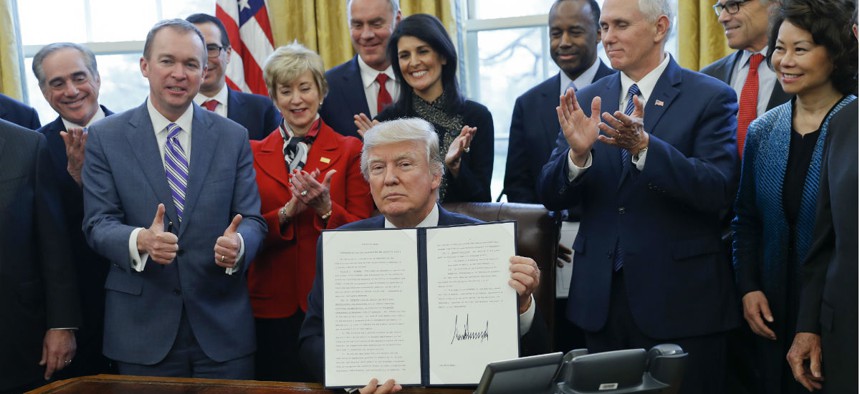
President Trump signed an executive order March 13 aimed at reforming the executive branch. AP Photo/Pablo Martinez Monsivais
How Trump’s Plan to Reorganize Government Could Work
We’ve seen this talk many times before, but done right, it could actually be successful.
On March 13, President Trump issued an executive order for a Comprehensive Plan for Reorganizing the Executive Branch. It calls for the OMB director and agency heads to develop plans for improving the efficiency, effectiveness and accountability of agencies, subcomponents and programs within 180 days. It also calls for a post in the Federal Register to solicit public input along with advice from experts inside and outside of government.
I like it.
No, I am not naïve, and yes, I have seen this many times before. But if done right, with a strong foundation and a plan, it could work. It could also be another once-and-done exercise that demonstrates little to no value. Many administrations have conducted similar exercises, most of which faded with the political passing. The Trump executive order runs the risk of having little or negative impact, reducing readiness and demoralizing employees. It also has the potential to do great things for our country.
Here are a few suggestions for how to make it work.
- It must involve Congress. Since lawmakers hold the statutory authority to reorganize as well as authorize programs, they must be in the mix. Capitol Hill and the administration must be on the same page.
- It should begin with a national summit that results in a strategic plan. This document must clearly articulate the business of government and the critical investments and changes that must be made. Created with bicameral and bipartisan support, it would provide the vision for reform.
- Someone must be in charge. Significant changes will need to grow roots, and that will take time—more time than is afforded in an election cycle. The only way to achieve staying power is through a term appointment entity such as envisioned under the Government Transformation Act.
- Reorganization must address vertical and horizontal programs. Vertical programs are those that directly serve the American people—emergency response, social insurance, defense, weather services, etc. Horizontal programs include those required to operate agencies—real estate, procurement, human resources, financial management, technology, etc. Moving to shared services is critical to success.
- Reform must cross agency boundaries. If the focus is within agency stovepipes, full efficiency and effectiveness will not be realized because there are many duplicative and overlapping programs. For example, numerous agencies are responsible for drug control policy and programs. How can efforts be consolidated to save money and improve efficiency?
- Accept that some investment will be necessary. It sometimes takes upfront investment to realize downstream savings and improved efficiency and effectiveness. Don’t be afraid to invest, but require both a return on investment and a return on expectations. Take advantage of policy changes to rethink business processes. For example, a tax code overhaul is a great time to change the way the IRS does business.
- Leverage what you have before you throw anything out. There are gems in government that can be repurposed and save money and time—people, processes and technology.
- Make hard decisions. Not everyone is going to like every decision, but decisions must be made, implemented and their benefits demonstrated. You can review and adjust later.
- Fix the foundation. Civil service reform, procurement reform and management reform will be essential to lasting success.
- Create a culture of sharing. Stop reinventing the wheel. By sharing data, tools, systems, processes, methods, etc. across agencies you can save significant time and money.
- Grow people. Make sure you develop up and coming leaders and managers. You need people in positions of authority who will champion the requirements of efficiency and effectiveness long after the initiative wanes.
- Address financial issues. Without addressing the debt and deficit and other big issues, sufficient resources may not be available to make systemic changes.
There are many more suggestions to be made. I will be sure to make my Federal Register comments. I hope you will too.
Steve Goodrich is the CEO of the Center for Organizational Excellence and the author of Transforming Government from Congress to the Cubicle.







